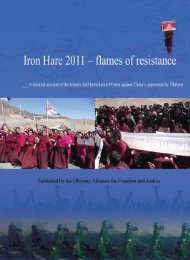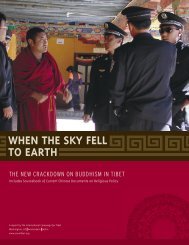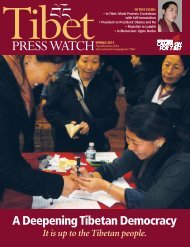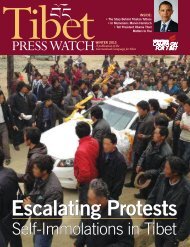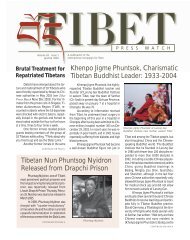DANGEROUS CROSSING: - International Campaign for Tibet
DANGEROUS CROSSING: - International Campaign for Tibet
DANGEROUS CROSSING: - International Campaign for Tibet
Create successful ePaper yourself
Turn your PDF publications into a flip-book with our unique Google optimized e-Paper software.
<strong>DANGEROUS</strong> <strong>CROSSING</strong>S: CONDITIONS IMPACTING THE FLIGHT OF TIBETAN REFUGEES, 2011<br />
80<br />
Long-staying <strong>Tibet</strong>an refugees face difficulties leaving Nepal. In<br />
one example, the US Government, prompted by the conditions<br />
<strong>for</strong> many <strong>Tibet</strong>ans in Nepal, offered to resettle <strong>Tibet</strong>an refugees<br />
who lacked permanent status in Nepal. Since then, the Nepal<br />
government has refused to allow the resettlement process to go<br />
ahead, despite repeated requests from the US Government. 182<br />
Notably, interviewees who had the financial means to receive private<br />
higher education and thus were able to build job opportunities<br />
in the private sector were markedly less pessimistic about<br />
living in Nepal. Tenzin Namgyal, a young man in his twenties<br />
from Tashi Palkhiel Pokhara, said: “A year ago I was dreaming of<br />
going to the USA, <strong>for</strong> new opportunities. But my business, and<br />
being with my family and friends, makes me happier here.” However,<br />
Tenzin and others like him are among the few who have<br />
managed to navigate the substantial documentation, property,<br />
business and education hurdles which the Nepal government has<br />
in place – something the majority of the <strong>Tibet</strong>an refugees have<br />
neither the capital nor capacity to do.<br />
Suppression of <strong>Tibet</strong>an Culture and Religion in Nepal<br />
Degradation, and even criminalization, of <strong>Tibet</strong>an culture and religion by Chinese<br />
government policies in <strong>Tibet</strong> is one of the main reasons that <strong>Tibet</strong>ans risk their lives<br />
crossing the Himalayas into freedom in exile. As testament to this, soon after its<br />
own establishment, the <strong>Tibet</strong>an exile government established the <strong>Tibet</strong>an Institute<br />
of Per<strong>for</strong>ming Arts (TIPA) in Dharamsala, India as a conservatory to preserve and per<strong>for</strong>m<br />
traditional songs and dances. In the relative havens that are Nepal, India and<br />
Bhutan, over the past 60 years, <strong>Tibet</strong>ans have been able to per<strong>for</strong>m, explore and<br />
develop their own unique cultural heritage away from the restrictions of Chinese<br />
rule, including celebrating key <strong>Tibet</strong>an festivals such as Losar (<strong>Tibet</strong>an New Year,<br />
February/March) and the Dalai Lama’s birthday (July 6).<br />
In Nepalis remote <strong>Tibet</strong>an refugee settlements, <strong>Tibet</strong>ans often feel that the <strong>Tibet</strong>an<br />
Buddhist culture is endangered by out-migration and a lack of funds. The inhabitants<br />
of Chialsa in the Solokhumbu region struggle to sustain their small monastery.<br />
Their 60-member per<strong>for</strong>ming arts troupe is now comprised of only a few young<br />
women who are left to per<strong>for</strong>m at ten important events in the <strong>Tibet</strong>an calendar.<br />
In the overcrowded city-based <strong>Tibet</strong>an settlements, the difficulties in maintaining<br />
culture are not about a lack of numbers. Where once <strong>Tibet</strong>ans in Nepal were able to<br />
freely gather to mark cultural events, over the past three years, state interventions<br />
in these have become common. A tacit understanding which existed between the



